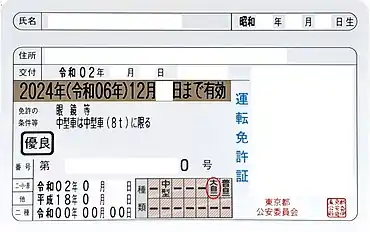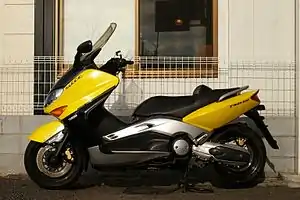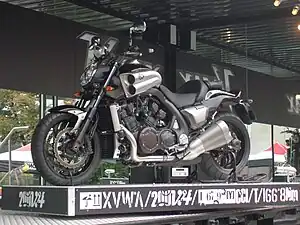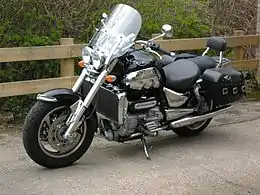Large two-wheel motor vehicle (Japan)
A large two-wheel motor vehicle (大型自動二輪車, ōgata jidō nirinsha), sometimes referred to as a heavy motorcycle, is one of the vehicle categories in the Road Traffic Act of Japan. Such vehicles (motorcycles) have a displacement of over 400 cc or a rated output of more than 20 kW.
Other categories include a small two-wheel motor vehicle (small motorcycle) and a standard two-wheel motor vehicle (ordinary motorcycle).
Heavy motorcycle license

A license to ride a heavy motorcycle can be obtained from the age of 18 onward. An AT license allows the rider to ride only AT motorcycles. Conversely, with a manual license, the rider is able to ride both AT and manual motorcycles. Riding a heavy motorcycle on a public road with an ordinary motorcycle license will result in the violation of "unlicensed driving".
License category history
A heavy motorcycle license and ordinary motorcycle license have been independent license categories since 1996.
In June 2005, it became possible to ride an AT (automatic transmission) motorcycle over 400 cc if the AT license for a heavy motorcycle was acquired.
In December 2019, the upper limit of the displacement of a heavy AT motorcycle that can be operated with a heavy AT motorcycle license became unlimited. This applied not only to those who would newly obtain a license after December 2019, but also to those who had an existing AT heavy motorcycle license. Furthermore, from the same day, motorcycles that use power sources other than internal combustion engines, such as electric motors, have also been classified as heavy motorcycles when the rated output exceeds 20 kW.
History of the 750 cc distinction
In the past, heavy motorcycles were referred to in Japan as "nanahan" (ナナハン) (literally, seven and a half) since they generally had no more than a 750 cc engine. This is because when the Honda CB750FOUR went on the market, its maximum speed exceeded 200 km/h (120 mph) and the National Police Agency (worried about excessive speed) requested motorcycle manufacturers to set up a voluntary regulation to limit the displacement of motorcycles that could be sold in Japan to 750 cc.
For that reason, Kawasaki motorcycles developed the Z2 in which the displacement of the Z1 had been suppressed to 750 cc, and each motorcycle company saw cases where the chassis of their export vehicles were fitted with a 750 cc engine until the mid-1980s
Since the self-regulation was abolished in 1988, many so-called "liter machine" models with engine displacements exceeding 1,000 cc have been released. Carried over from past days, fees for shipping motorcycles on ferries in Japan still vary depending on whether the vehicle's displacement exceeds 750 cc or not.
Categories
Some of the vehicle categories under Japanese law are as follows:
| Name | Japanese | Description |
|---|---|---|
| Moped | 原動機付自転車 | Any motorcycle with engine displacement of 50 cc or less. |
| Small motorcycle | 小型自動二輪車 | Any motorcycle with engine displacement over 50 cc but no more than 125 cc. |
| Ordinary motorcycle | 普通自動二輪車 | Any motorcycle with engine displacement over 50 cc but no more than 400 cc. |
| Heavy motorcycle | 大型自動二輪車 | Any motorcycle with engine displacement over 400 cc. |
Other details
| License type | Minimum age | Displacement | Loading capacity | Legal speed limit (general roads) | Expressway riding | Pillion riding | Bus lane riding |
|---|---|---|---|---|---|---|---|
| Moped | 16 | Up to 50 cc | 30 kg (66 lb) | 30 km/h (19 mph) | No | No | Yes |
| Small motorcycle (incl. AT) | 16 | Up to 125 cc | 60 kg (130 lb) | 60 km/h (37 mph) | No | Yes (1 year after license acquisition) | No |
| Ordinary motorcycle (incl. AT) | 16 | Up to 400 cc | 60 kg (130 lb) | 60 km/h (37 mph) | Yes | Yes (1 year after license acquisition) | No |
| Heavy motorcycle (incl. AT) | 18 | No limit | 60 kg (130 lb) | 60 km/h (37 mph) | Yes | Yes (1 year after license acquisition) | No |
Applicability in other countries
Great Britain has an exchange agreement with Japan[1] (and with 16 other countries/regions) which allows the holder of a Japanese heavy motorcycle license who is deemed to be resident in the UK to exchange it for an equivalent British license (Category A). To do this, the holder must send the license, a translation thereof, an application form and a fee to the DVLA or DVA (for Northern Ireland).
Gallery
 Yamaha TMAX500 (499 cc)
Yamaha TMAX500 (499 cc) Yamaha VMAX (1,679 cc)
Yamaha VMAX (1,679 cc) Triumph Rocket III (2,294 cc, the largest-displacement engine of any production motorcycle)
Triumph Rocket III (2,294 cc, the largest-displacement engine of any production motorcycle)
See also
References
- "Gov.uk". Exchange a foreign driving licence. Retrieved 29 October 2020
External links
- Statistics about acquiring a Shipping (Shipping by Motorcycle Enthusiasts)
- (in Japanese) Information about acquiring a license (Japan Motorcycle Promotion & Safety Association)